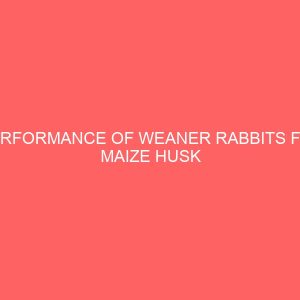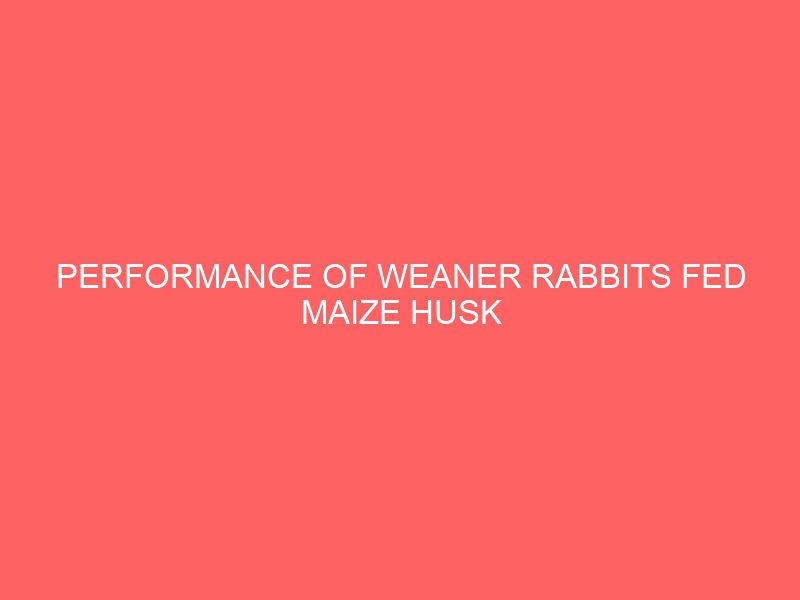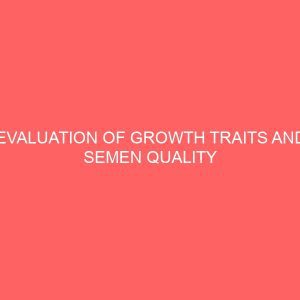Description
ABSTRACT
Two experiments were conducted to evaluate the performance of weaner rabbits fed maize husk based diets with or without enzyme supplementation. In the first experiment, thirty six weaner rabbits were used for the study. Maize husk replaced rice offal at 0, 4, 8, 12, 16 and 20% inclusion levels for treatments one to six respectively. Each treatment consisted of six rabbits and each rabbit served as a replicate in a completely randomized design. In the second experiment, each treatment consisted of six rabbits and each rabbit served as a replicate in a completely randomized design. The experimental diets consisted of 20% maize husk supplemented with enzyme at 0.00, 0.02, 0.03 and 0.04% for treatments one to four respectively. Maize husk had significant (P<0 .05="" affected="" and="" average="" b="" body="" cell="" conversion="" cost="" daily="" effect="" feed="" final="" gain.="" gain="" haemoglobin="" kg="" level="" not="" on="" packed="" per="" ratio="" significantly="" volume="" weight="" were="">0.05) by dietary maize husk. However, total protein (TP) was significantly affected. Crude protein, crude fibre, ether extract and nitrogen free extract significantly decreased (P<0 .05="" 0.02="" 20="" 4="" all="" and="" as="" at="" average="" be="" best="" can="" carcass="" concluded="" conversion="" cost="" could="" daily="" declined="" diets.="" diets="" digestibility="" dressed="" dressing="" enzyme="" evaluation.="" experiment="" fed="" feed="" for="" four="" gain="" gave="" husk.="" husk="" if="" in="" inclusion="" increased.="" increased="" increasing="" is="" it="" kilogram="" level.="" level="" levels="" maize="" nutrient="" obtained="" of="" parameters="" per="" percentage="" performance="" poorest="" rabbits="" ratio="" result="" results="" second="" significantly="" skin="" slaughter="" span="" studied="" supplementation="" supplemented="" that="" the="" their="" therefore="" thigh="" this="" to="" tolerate="" twenty="" up="" used.="" was="" weaner="" weight="" were="" while="" with="">
CHAPTER ONE
1.0 INTRODUCTION
Inadequate animal protein in the diets of people in developing countries has called for the integration of some micro livestock in the farming system as sources of animal protein. Productivity of these livestock will depend to a large extent on their ability to utilize feeds that have no value in human diets. Increased rabbit production is one way of meeting the animal protein requirements of the Nigerian populace (Iyeghe-Erakpotobor et al., 2002). Increased production of breeders can be ensured through proper nutrition and feeding of weaner rabbits. Supply of meat always remains a major constraint in animal production due to the ever increasing cost of conventional feedstuffs occasioned by the competition between man and livestock (Amaefule et al., 2004). The key to abundant animal production is the availability of cheap and balanced feed. Feed dictates how many animals you can grow and how fast they can mature for the market (Aduku, 1992).
Weaner rabbits require 2400-2600 kcal ME/kg of feed 15% crude protein and 9-17% crude fibre (Aduku, 2005). The fibre requirement is higher than that of monogastric animals, because rabbits have a large caecum with microbial organisms which aid in the breakdown of the high fibre. Rabbits possess various attributes that are advantageous in comparism to other livestock, Taylor et al., (1989) noted that rabbit meat is of excellent protein quality, low in total as well as saturated fat, cholesterol and sodium. Therefore, rabbit production is considered a good source of meat in the developing countries where there is an abundance of agro-industrial by-product feedstuffs.







